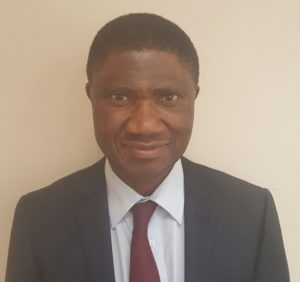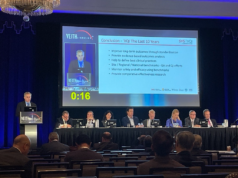
A randomised controlled trial has found that clinical and patient-reported outcomes following radiofrequency ablation (RFA) of varicose veins with compression are no better than without compression. Madu Onwudike (Manchester University NHS Foundation Trust, Manchester, UK) and colleagues conducted the study, which appeared as an Editor’s Choice paper in the July edition of the European Journal of Vascular and Endovascular Surgery (EJVES).
The authors detail that the target vein occlusion rate was not influenced by whether post-procedure compression was worn or not following RFA of varicose veins, where phlebectomies had not been performed adjunctively. Similarly, there was no evidence that quality of life (QoL) scores, patient satisfaction, and complications were inferior in the group that had no post-procedure compression.
Onwudike and colleagues write that post-procedure limb compression, hitherto routine following open varicose vein surgery, has been extended to endovenous procedures. “However,” they comment, “no robust evidence exists to support this practice”. Therefore, the investigators designed the present study to evaluate the clinical and patient-reported outcomes with and without post-procedure leg compression following RFA.
They note a few studies that raise doubts about the necessity for post-procedure compression, including a 2017 Annals of Vascular Surgery study by Ayo et al, which compared seven-day compression versus no compression and reported no difference in clinical (vein obliteration) and patient-reported outcomes (pain, ecchymosis, and QoL) following endovenous ablation. However, Onwudike et al’s study is the first to investigate the role of post-procedure compression where all the veins were exclusively ablated using RFA.
In this single-centre, prospective, non-inferiority randomised controlled trial, the investigators recruited adult patients into two groups: A (RFA with compression stockings for two weeks) and B: (RFA alone). The primary outcome was ultrasound determined target vein obliteration at 12 weeks. Secondary outcome measures included a QoL score (Aberdeen Varicose Vein Severity Score [AVSS] and Revised Venous Clinical Severity Score [RVCSS]), patient satisfaction, pain score, and complications.
In total, the investigators recruited 100 consecutive patients—51 to group A and 49 to group B—classified as clinical class C2–C6 of the Clinical-Etiological-Anatomical-Pathophysiological (CEAP) classification.
Onwudike and colleagues write in EJVES that, at 12 weeks, the occlusion rate of the target vein was similar in both groups at 98% (n=47) and 98% (n=45), respectively (p=1).
They also report that here was no statistically significant different in mean AVSS 6 vs. 5 (mean difference -1, 95% confidence interval [CI] -2–3, p=0.57) and mean RVCSS 3 vs. 4 (mean difference 1, 95% CI -1–2, p=0.46) scores at 12 weeks.
Finally, they observed comparable patient satisfaction scores (p=0.72) and pain score 2 vs. 2 (p=0.92) were achieved in both groups. Two patients in each group developed deep vein thrombosis at two-week follow-up (p=1 for above the knee and p=1 for below the knee).
In the discussion of their findings, Onwudike et al remark that the method of randomisation and the fact that both the chief investigator and the statistician were blinded to the allocated group reduced the risk of bias. In addition, the low dropout rate reduced the risk of type 2 error.
However, they also note some limitations. Firstly, Onwudike and colleagues recognise that the study is from a single centre and it only reports short-term results. “Long-term follow-up analysis may give further insight into differences in success rates based on compression therapy use,” they write.
Overall, while the authors “accept that the place or duration of compression post-RFA is far from settled,” they expect that this study will “contribute to development of the body of knowledge on the subject”.
Onwudike et al elaborate that, while earlier studies concentrated on the duration of compression, the present study and that of Ayo et al have moved the discussion on to answering the question of whether compression is required at all following RFA in situations where phlebectomies have not been performed. “This is consistent with a publication by the UK National Institute for Health and Care Excellent (NICE), which highlighted the knowledge gap in the role of compression following endothermal ablation,” they remark.
Furthermore, they note that this study is also a partial response to the European Society for Vascular Surgery (ESVS) guidelines, which recommend the need for further studies in this area. Onwudike and colleagues state that, if the present findings are confirmed by larger studies, “it is likely that the current recommendation of post-procedural compression for all cases of open surgery and endovenous superficial vein procedures will be revised”.
The authors summarise: “This trial supports the conclusion that the widely practised use of compression after RFA adds no clinical benefit for the patients.” However, they add that a much larger study, “preferably a multicentre trial,” may be required to confirm their findings.









